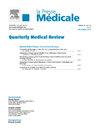Pancreatic islet organoids and organoids on-chip for type 1 diabetes
IF 3.4
3区 医学
Q1 MEDICINE, GENERAL & INTERNAL
引用次数: 0
Abstract
Type 1 Diabetes (T1D) is a highly complex and prevalent metabolic disease caused by dysfunctions of pancreatic islets. Over the past decade, diabetes research and treatments have focused on insulin restoration and glucose homeostasis, especially the regenerative approaches for stem cell based therapies for T1D. Nevertheless, unravelling the islet developmental processes and physiopathology of diabetes requires development of in vitro models that mimic the structure and function of islet of Langerhans.
Organoids have progressively revolutionized three-dimensional cell culture allowing development of more physiologically relevant models that recapitulate cellular interactions and responses more accurately.
Here, we provide insights into advanced islet organoid models focusing on their generation, characteristics, applications, and challenges. We discuss state-of-the-art tissue engineering strategies to recapitulate islet development and pancreatic niche microenvironment by exploring different cell sources of insulin-producing cells, including primary islet cells and cell line aggregation, transdifferentiation from adult somatic cells, and differentiation from stem cells. We discuss the significance of replicating the islet microenvironment through extracellular matrices and scaffolds, as well as vascular and immunomodulatory approaches. We highlight the potential of organ-on-chip technologies to closely recapitulate the complex microenvironment of pancreatic tissues providing platforms for disease modelling, drug screening and regenerative medicine. Despite the challenges, islet organoids combined with microfluidics represent a promising tool for the understanding of T1D pathogenesis and developing innovative therapies.
胰岛类器官和类器官芯片治疗1型糖尿病。
1型糖尿病(T1D)是由胰岛功能障碍引起的高度复杂和普遍的代谢性疾病。在过去的十年中,糖尿病的研究和治疗主要集中在胰岛素恢复和葡萄糖稳态,特别是基于干细胞的再生方法治疗T1D。然而,揭示胰岛发育过程和糖尿病的生理病理需要发展模拟朗格汉斯胰岛结构和功能的体外模型。类器官已经逐渐彻底改变了三维细胞培养,允许开发更生理相关的模型,更准确地概括细胞相互作用和反应。在这里,我们提供了对先进的胰岛类器官模型的见解,重点是它们的产生、特征、应用和挑战。我们讨论了最先进的组织工程策略,通过探索胰岛素产生细胞的不同细胞来源,包括原代胰岛细胞和细胞系聚集、成人体细胞的转分化和干细胞的分化,来概括胰岛的发育和胰腺生态位微环境。我们讨论了通过细胞外基质和支架以及血管和免疫调节途径复制胰岛微环境的意义。我们强调了器官芯片技术的潜力,它可以紧密地概括胰腺组织的复杂微环境,为疾病建模、药物筛选和再生医学提供平台。尽管存在挑战,但胰岛类器官结合微流体技术为了解T1D发病机制和开发创新疗法提供了一个很有前景的工具。
本文章由计算机程序翻译,如有差异,请以英文原文为准。
求助全文
约1分钟内获得全文
求助全文
来源期刊

Presse Medicale
医学-医学:内科
自引率
3.70%
发文量
40
审稿时长
43 days
期刊介绍:
Seule revue médicale "généraliste" de haut niveau, La Presse Médicale est l''équivalent francophone des grandes revues anglosaxonnes de publication et de formation continue.
A raison d''un numéro par mois, La Presse Médicale vous offre une double approche éditoriale :
- des publications originales (articles originaux, revues systématiques, cas cliniques) soumises à double expertise, portant sur les avancées médicales les plus récentes ;
- une partie orientée vers la FMC, vous propose une mise à jour permanente et de haut niveau de vos connaissances, sous forme de dossiers thématiques et de mises au point dans les principales spécialités médicales, pour vous aider à optimiser votre formation.
 求助内容:
求助内容: 应助结果提醒方式:
应助结果提醒方式:


